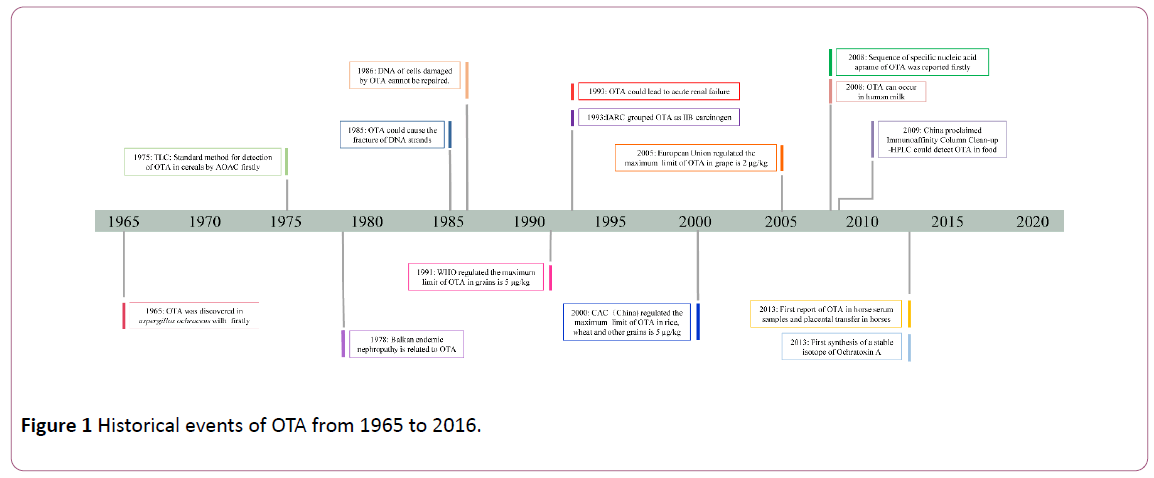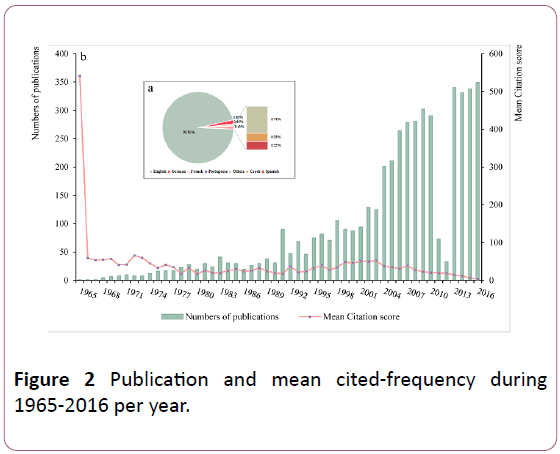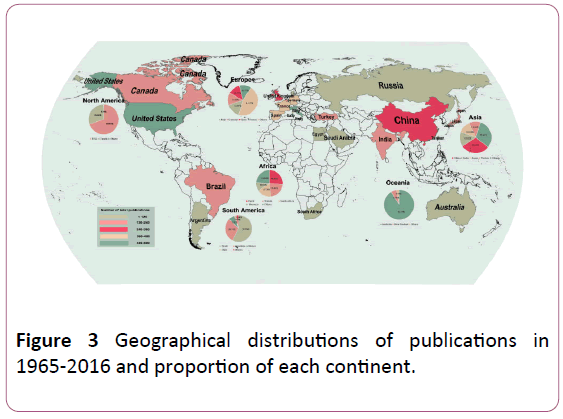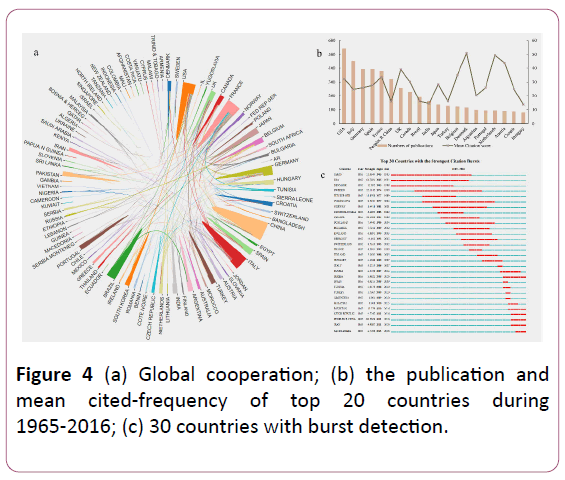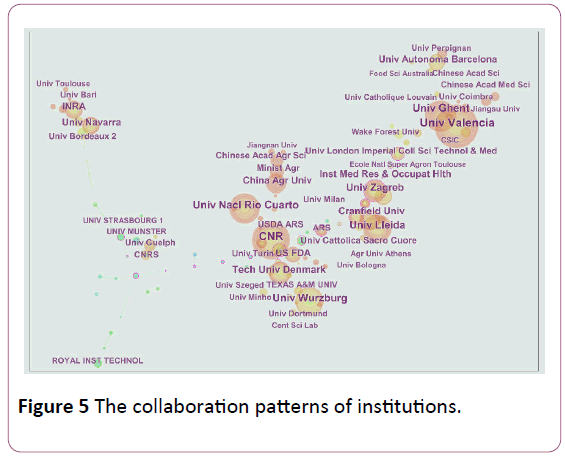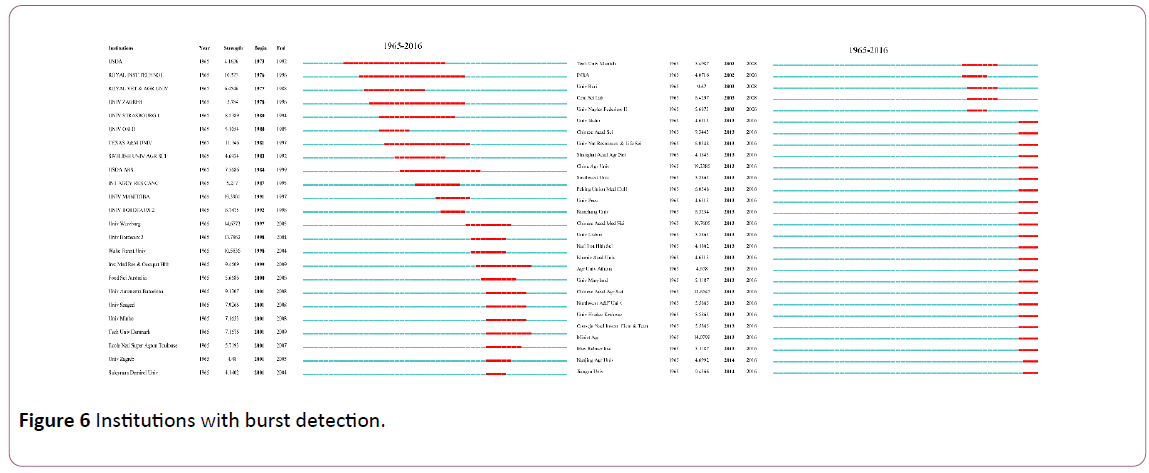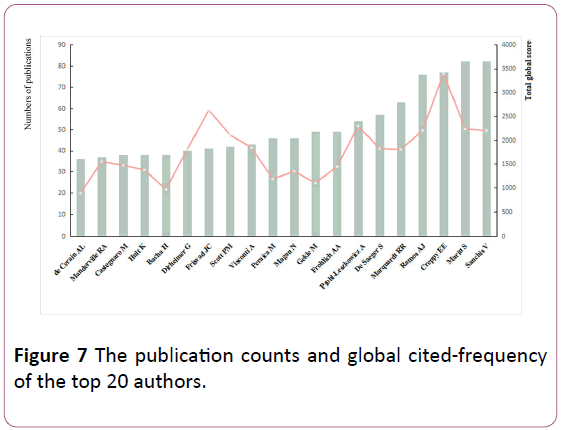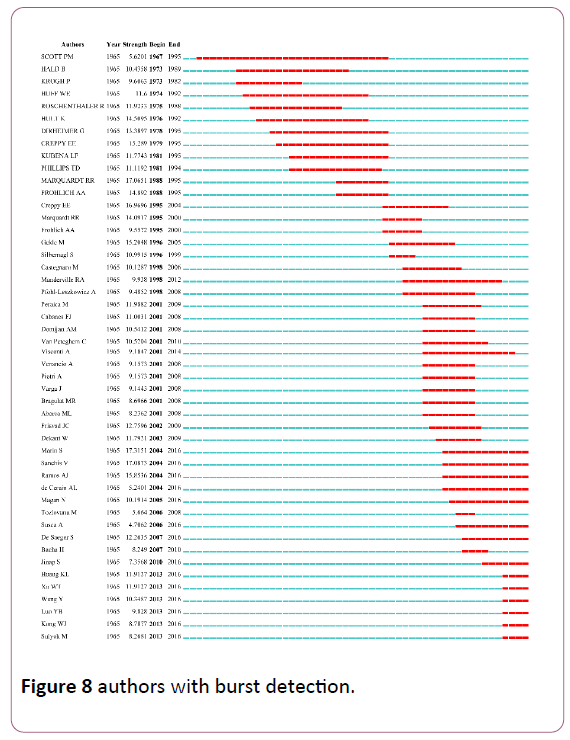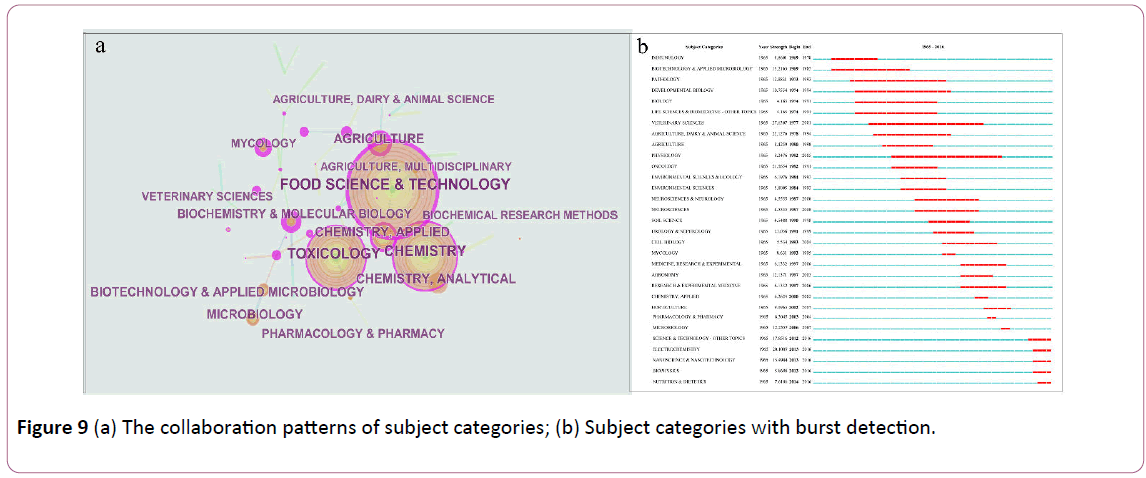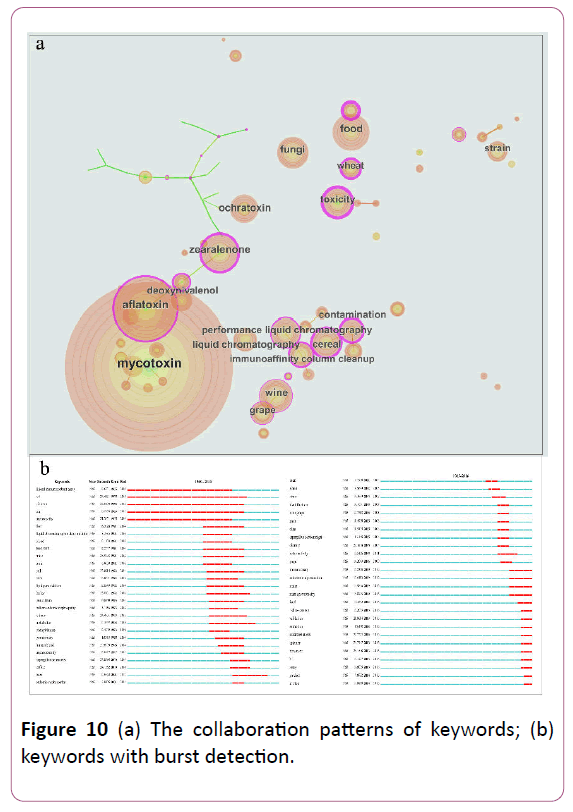ISSN : 2393-8862
American Journal of Pharmacology and Pharmacotherapeutics
Worldwide Scientific Trends on Ochratoxin-A During 1965ÃÆâÃâââ¬Ãâââ¬Å2016
Xiang Zhang, Wanqi Xu and Linfang Huang*
Institute of Medicinal Plant Development, Chinese Academy of Medical Sciences, Peking Union Medical College, Beijing, P.R. China
- *Corresponding Author:
- Linfang Huang
Institute of Medicinal Plant Development
Chinese Academy of Medical Sciences
Peking Union Medical College
Beijing 100193, P.R. China
Tel: +966122328888
E-mail: lfhuang@implad.ac.cn
Received Date: December 02, 2018; Accepted Date: December 26, 2018; Published Date: December 28, 2018
Citation: Zhang X, Xu W, Haung L (2018) Worldwide Scientific trends on Ochratoxin-A During 1965–2016. Am J Pharmacol Pharmacother Vol.5 No.2:7. doi: 10.21767/2393-8862.10017
Abstract
The contamination in foodstuff by ochratoxin A (OTA) has become a major problem to humans and animals. Hence, many countries have expressed interest on researching OTA. However, the current development trends of OTA are not well understood. This study discussed the research trends and hotspots of OTA and investigated the contribution of research from seven areas: countries, institutions, authors, publications, subject categories, keywords and journals. Related publications on OTA during 1965–2016 were retrieved from the Web of Science database. CiteSpace V and bibliometric technologies combined with network analysis were used in exploring research hotspots and basic statistics of OTA. A total of 4889 articles, which were contributed from 103 countries, were identified. Most countries are from Europe, such as Italy, Germany and France. The USA, which ranks first, accounts for 11.1% of the articles with 543 records. Additionally, the top three high-cited countries are Denmark, the Netherlands and Austria, all from Europe. Surprisingly, China has a large number of publications which accounts for 6 but lesser citation scores. In the subject of nutrition and dietetics, keywords ‘aptamer’ and ‘biosensor’ are emerging, which are of increasing concern. This finding indicated that the literature growth in the field of OTA would be expanding rapidly in the future. European countries are the most influential countries, especially Denmark, the Netherlands and Austria. New technologies for detecting and identifying OTA as well as nutrition and dietetics would be paid more attention by scholars or the society.
Keywords
Ochratoxin A; Food contamination; Bibliometric analysis; Research trends; Nutrition and dietetics; Aptamer and biosensor
Introduction
With the increasing awareness on healthy diet, more and more people pay attention to the security of food. Ochratoxin A (OTA, C20H18O6NCl) is the most important mycotoxin like aflatoxins from Aspergillus species and is one of the most toxic metabolites produced by various Aspergillus and Penicillium species [1-4]. OTA can breed at 15 and 15%–19% humidity in grains [5,6], such as corn, strain and wheat, and also in edible medicinal plants, such as glycyrrhizae radix et rhizome and Panax ginseng. Additionally, OTA is found in some plant products, such as grape wine, spices and coffee [7]. In animal-derived food, pork products and milk of cows are the main sources of this toxin [1]. OTA exerts carcinogenic, immunotoxic and teratogenic effects on rats and likewise poses health hazards to humans [8-13]. Balkan endemic nephropathy is the most common disease caused by OTA. Hence, publications on technologies for the detection and identification of OTA have emerged. In the past, high-performance liquid chromatography, enzyme-linked immunosorbent assay and mass spectrometry were applied to detect OTA. However, these methods are expensive, time consuming and require specific sophisticated instruments. Owing to these disadvantages, some emerging technologies have been developed. Electrochemical aptasensors and aptamer-based sensors are typical and widespread technologies which have been recently applied to food toxin detection owing to their rapid detection and exceptional sensitivity. Seyed Mohammad Taghdisia designed a novel fluorescent aptasensor based on gold nanoparticles for detecting OTA, and this technology has been successfully utilized on grape juice. Yang determined OTA in corn using a fabricated instrument with electrochemiluminescence biosensor, aptamer and hyperbranched rolling circle amplification and studied its stability, reproducibility and selectivity. They also indicated that the technology could produce good results and be used in food safety control [14-17]. On the basis of the health risks involved with OTA, the International Agency for Research on Cancer has grouped OTA as IIB carcinogen. The Committee on Food Additives and Contaminants of the World Health Organization established the maximum limit standard in 1997, that is, 5 μg in 1 kg of grain products to decrease hazard to humans. In 2006, the European Union passed a legislation implementing the maximum limitation of OTA in a certain number of products [18].
However, the current research situation, potential hotspots and development trends on OTA remain undetermined. In this study, we reveal the basic statistics and research hotspots related to OTA from seven aspects, including publications, countries, institutions, authors’ contributions, subject categories, keywords and journals. We examine 4889 publications on the Web of Science (WoS) database from 1965 to 2016 by CiteSpace V software and bibliometrics methods combined with network analysis. We mainly evaluate the growth trend and quality of publications and the top 20 research countries. We summaries the current development trends on OTA by analyzing the burst detection of subject categories and keywords. Moreover, several suggestions for improving research situation are given.
Literature Review
Data and methods
We accessed the WoS database using the topic ‘OTA’ as the search term for collecting 4889 documents during 1965–2016. Each paper includes the title, authors, institutions, abstracts, keywords and cited references.
We utilized the information visualization software Cite Space V (Drexel University, Dr. Chaomei Chen) and traditional methods for the analysis of the following terms [19]:
Basic statistics: The publications and mean citation score per year, distributions of geography, main institutions, influential authors, top publishing journals, articles with highest impact factor and the most cited articles were covered, which can indicate the importance of OTA between different countries and stages.
Study hotspots: Subject categories and keywords to investigate the hotspots and trends within the field were used. We analyzed main subject categories, capital keywords and their burst detection, which was used to measure bursts keywords or subject categories as indicators of emerging trends that may influence scholars’ prospective research selections.
Results and Discussion
Historical events of OTA
We summarized the historical events of OTA from 1965 to 2016. We found a total of 15 important events and most of them could be grouped as regulations, contaminated resources, related diseases and detecting techniques. For example, in 1993, IARC grouped OTA as IIB carcinogens and researchers found that Balkan endemic nephropathy is related to OTA in 1978. In addition, WHO regulated the maximum limit of OTA in grains is 5 μg/kg in 1991, CAC, an institution in china proclaimed the maximum limit of OTA in rice, wheat and other grains is 5 μg/kg in 2000 and in 2005, European Union declared the maximum limit of OTA in grape is 2 μg/kg. Hence, we can easily conclude that OTA’s virulent is strong. Moreover, TIC and Immunoaffinity Column Clean-up combined HPLC regulated them as the standard methods for detecting OTA by AOAC and China respectively Figure 1.
Quantity of publications and growth trend
OTA-related literature published from 1965 to 2016 was obtained from the WoS database. A total of 4889 documents can be retrieved. Nearly all the papers were in English, which account for 95.91%, and others were in 14 different languages, led by German (1.82%), French (0.65%) and Portuguese (0.43%), all are mainly spoken in Europe. Some others were in Czech, Spanish and Chinese Figure 2.
Figure 2 shows the development on the number of publications by year, as well as the mean citation score per year. Based on the growth trend, the whole course can be roughly split into three stages. The early stage was in 1965-2010, which was characterized by a steady growth. However, the second stage in 2011-2012 witnessed that the trend fell sharply. During the last stage in 2013-2016, publications exponentially increased, which was caused by aflatoxin contamination in milk and dog food in 2013 throughout Europe and the USA, respectively. The published articles rose to 349 during 1965-2016, which indicates that OTA has become a popular topic in the scientific community. The trend shows that additional articles on OTA may be available in the coming years. Furthermore, the mean citation score can be divided into two stages with greater difference than the growth trend of publications. The first year (1965) was the first stage with the citation score of 542. Surprisingly, in 1967, the decrease in the score of citation was notable from 542 to 59. Then, it showed a relatively steady state until 2016 with only 3.
Countries’ contributions to global publications
A total of 103 countries met the search criteria for OTA. Figure 3 elucidates the geographical distribution of all papers on their representative countries. North America, Europe and Asia have published the majority of documents. In Europe, Italy accounted for approximately 14.07% followed by Germany (12.20%) and Spain (12.17%). In Asia, publications are primarily distributed in China (29.94%) followed by India (15.02%) and Japan (12.69%). The numbers of papers from North America were mostly from the USA (69.97%) and Canada (29.64%). The situation indicates that Europe always pays attention on healthy eating and that their food sources, such as milk, meat, corn and wheat, are easily contaminated by OTA.
We utilised the bibliometrics website (https://bibliometric.com/) for examining the country collaboration network, as shown in Figure 4. The greater number of lines stretch out in one country, the stronger the cooperation with other countries. Figure 4 shows that the top three countries with external cooperation are France, the USA and Italy. Some independent countries, such as Ukraine, Tanzania and Benin, have no cooperation. We hope that each country promotes international collaboration for reform and innovation in OTA development.
Figure 4 lists the top 20 productive countries, led by the USA, which published the most articles (543 records), followed by Italy (453 records) and Germany (393 records). However, the top three countries for mean citation score in OTA research were Denmark, the Netherlands and Austria, suggesting that they have published many high-quality papers. Interestingly, all of them are from Europe. China has published many articles of 321 records, which ranked sixth, but with lesser mean citation score like the top three countries. Hence, more efforts should be exerted to raise the influence of their publications.
Burst detection is a computational tool for identifying abrupt variations on events. The red line segment manifests the duration of change, and the count of strength indicates the intensity of change. The countries with the strongest citation bursts in the flied of OTA are listed in Figure 4c. The USA possessed the strength of 61.70 from 1965 to 1994. We conclude that the USA carried out a considerable amount of work on OTA during the time span. Unexpectedly, China had the highest strength of 81.56 from 2011 to 2016. We infer that OTA has attracted considerable attention, owing to aflatoxin contamination on the gutter oil and old oil and slop incidents that occurred in 2011. Scholars from Saudi Arabia, who contributed 16 papers, started showing more interest on OTA from 2013 to 2016.
Institution statistics
Figure 5 shows the main international collaborations between the main institutions. Results reveal that 4889 papers, which reflect the research on OTA, were distributed in 2961 institutions and have been watched extensively worldwide. Figure 5 graphically presents that most institutions are from Europe, which corresponds to the data of the main research countries. In general, the larger the circle, the more the papers published by the institution [20], due to a potentially closer cooperation between institutions within the same region. Hence, we conclude that the top three productive institutions were the University of Valencia (93 records), University of Wurzburg (85 records) and CNR (82 records) with the proportion of 1.90%, 1.74% and 1.68%, respectively. The collaboration in OTA research was mostly in the same geographic area such as INRA, University of Navarra and University of Bari (top-left corner), which are all from Europe. In China, China Agricultural University, Chinese Academy of Agricultural Sciences and Jiangnan University (middle-upper part) work closely with each other but with less relationships with foreign countries. Royal Institute of Technology has no collaboration with other institutions.
Figure 6 displays the burst detection of 52 institutions but with no higher strength among them. However, we found that burst detection started in 2013 in many institutions from Europe, North America and Asia. We implied that OTA became a pivotal topic due to the aflatoxin contamination in milk and dog food in 2013 throughout Europe and the USA, respectively. Chinese institutions have higher burst strength during 2013–2016, including China Agricultural University, Chinese Academy of Agricultural Sciences and Chinese Academy of Medical Sciences with the count of 19.34, 12.65 and 10.76.
Author statistics
Results show that 4889 papers were produced by 10437 authors. Figure 7 indicates the rankings of the top 20 fruitful authors who have 30 or more publications in this field. Of the top 20 productive authors, four are from France and four from Spain, both ranking the first, three are from Canada and two are from Germany. In addition, 95% of the top 20 authors except for Bacha H (Tunisia) come from European countries. Authors who published the most on OTA are Marin S and Sanchis V, each with 82 records and both from Spain. However, the top three authors with the highest citation score are Creppy EE, Pfohl-Leszkowicz A and Frisvad JC. Frisvad JC is the 14th productive author with 64 points in the mean citation score per article.
The burst detection of 48 authors is shown in Figure 8. The top 20 productive authors all exist in burst on OTA. Among them are three Spanish, namely, Marin S, Sanchis V and Ramos AJ, with the strength of 17.32, 17.09 and 15.85, respectively, during 2004-2016.
They are all from the University of Lleida, suggesting that they might contribute more publications on OTA in the future. Additionally, Huang KL, Wang Y and Xu WT are from China Agricultural University, with an average strength of 11.39 during 2013-2016. Xu WT had the same strength as Huang KL.
Therefore, we speculate that many authors have jointly authored a ton of these articles, which is consistent with the actual condition.
Subject category statistics
The subject categories can demonstrate which point is being focused on with a great concern currently on OTA. Our results revealed a wide range of subject categories on OTA with 94 counts, which remarkably cover food science and technology, chemistry and toxicology Figure 9, with 1625, 1273 and 1248 publications. They all can be classified as detection means and research with regard to OTA. The larger the purple ring (named centrality), the greater the transformation potential. As shown in Figure 9, the top three subject categories with transformation potential are biochemistry and molecular biology, microbiology and agriculture with the centrality of 1.18, 0.93 and 0.73, respectively, which are the essential research and the main source of OTA.
Figure 9 reveals the burst detection of 31 subject categories. We concluded that along with the situation of science and technological progress, other novel methods could be applied for determining OTA. Currently, electrochemistry and nanoscience and nanotechnology possess the highest burst strength of 20.10 and 15.49 from 2013 to 2016. Both are novel methods. Nutrition and dietetics also burst with 7.61 strength during 2014-2016, which illustrates that people around the world are increasingly concerned about food safety and healthy diet. Furthermore, with the increase in health awareness and economics, many research communities possibly pay more attention to the risk assessment of OTA on healthy eating.
Keyword statistics
Keyword analysis in scientific articles is a point with great interest for exploring and following the many branches of science and engineering [21]. As a result of our study, 5968 different words were retrieved within OTA field during 1965-2016. Figure 10 shows some high-frequency words, which can be roughly classified into four aspects. The largest one is toxin, with mycotoxin and aflatoxin as the top two keywords and the frequency of 1487 and 594, respectively. Second are the common detection methods such as performance liquid chromatography (295), liquid chromatography (254) and immunoaffinity column cleanup (228).
In addition, food (372), wheat (217), wine (325), grape (232) and strain (224) can be sorted into one group called the source of OTA. The last one is OTA-related chemical constituents including zearalenone (374) and deoxynivalenol (267). More importantly, toxicity, which is a character of OTA with the frequency number of 291, ranks 10.
The burst detection of 46 keywords is summarised in Figure 10. Three burst times occurred due to nephropathy, Balkan endemic nephropathy and endemic nephropathy with the burst strength of 21.38, 5.12 and 8.04, respectively. Nephropathy, which is one of the main diseases caused by OTA, was the hotspot of concern to research communities before 2004. Currently, aptamer and biosensor, two original detection technologies that can be classified as electrochemistry, have the upper burst strength of 24.78 and 25.15, implying that the new technologies are constantly being developed and possess advantages in OTA detection. Risk assessment related to the subject category of nutrition and dietetics has the strength of 13.20 from 2013 to 2016 owing to the continuous occurrence of poisoning incidents. We infer that it will continue to be the focus of attention because of the increasing awareness of people globally on healthy eating. Moreover, we suggest establishing an exclusive database for OTA, which contains its characteristics, source and biological toxicity and even the analysis of poisoning cases, for the global people. Finally, the world should establish a standard on the maximum OTA in certain food.
Journals and publications
The literature about OTA is from 939 journals. The top 20 productive journals are listed in Table 1. Three remarkable journals are the International Journal of Food Microbiology with 175 articles, Food Control with 155 articles and Food Additives and Contaminants with 151 articles, all with more than 150 records. The first two are from the Netherlands; the third one is from the UK. Up to 70% of the journals come from Europe, mainly from the Netherlands (9), Germany (2) and the UK (2). Six journals (30%) are from the USA.
| Journal | Number | Percentage (%) | IF | Region |
|---|---|---|---|---|
| International journal of food microbiology | 175 | 3.58 | 3.339 | Netherlands |
| Food control | 155 | 3.17 | 3.493 | Netherlands |
| Food additives and contaminants | 151 | 3.09 | 2.047 | UK |
| Food additives and contaminants part a-chemistry analysis control exposure & risk assessment | 140 | 2.86 | 2.047 | UK |
| Journal of agricultural and food chemistry | 136 | 2.78 | 3.154 | USA |
| Toxins | 113 | 2.31 | 3.03 | Switzerland |
| Food and chemical toxicology | 108 | 2.21 | 3.778 | Netherlands |
| World mycotoxin journal | 95 | 1.94 | 2.189 | Netherlands |
| Toxicology letters | 84 | 1.72 | 3.858 | Netherlands |
| Journal of food protection | 83 | 1.7 | 1.417 | USA |
| Journal of chromatography | 70 | 1.43 | 3.981 | Netherlands |
| Poultry science | 64 | 1.31 | 1.908 | USA |
| Journal of aoac international | 63 | 1.29 | 0.962 | USA |
| Food chemistry | 61 | 1.25 | 4.529 | Netherlands |
| Analytical and bioanalytical chemistry | 56 | 1.15 | 3.431 | Germany |
| Toxicology | 55 | 1.12 | 3.582 | Netherlands |
| Toxicology and applied pharmacology | 55 | 1.12 | 3.791 | Netherlands |
| Mycopathologia | 50 | 1.02 | 1.71 | Germany |
| Applied and environmental microbiology | 48 | 0.98 | 3.807 | USA |
| Journal of the science of food and agriculture | 45 | 0.92 | 2.463 | USA |
Table 1: The information about top 20 highest publishing journals.
The higher the impact factor, the greater the breakthrough in the field of OTA. Table 2 displays the top 18 articles from 10 journals with the highest impact factor. Seven publications (38.9%) were published before 2000. ‘OTA in retail flour’ was published in The Lancet with an impact factor of 47.83. Three articles were published in Nature before 1975. Five articles were published in Studies in Mycology with an impact factor of 14.00. The paper titled ‘Ochratoxin production and taxonomy of the yellow aspergilli (Aspergillus section circumdati)’, which is the nearest one, was published in 2014 [22-34].
| Rank | Title | Year | Journal | IF | Reference |
|---|---|---|---|---|---|
| 1 | Ochratoxin A in retail flour | 1978 | Lancet | 47.831 | [22] |
| 2 | Genome sequencing and analysis of the versatile cell factory aspergillus niger | 2007 | Nature Biotechnology | 41.667 | [23] |
| 3 | Ochratoxin A: a toxic metabolite produced by aspergillus ochraceus wilh; | 1965 | Nature | 40.137 | [2,3,24] |
| Detection and estimation of ochratoxin A; | 1966 | ||||
| Relationship of ochratoxin-A to foetal death in laboratory and domestic animals | 1971 | ||||
| 4 | Determination of mycotoxins in human foods | 2008 | Chemical Society Reviews | 38.618 | [25] |
| 5 | Ochratoxin A may cause testicular cancer | 2002 | Lancet Oncology | 33.9 | [26] |
| 6 | Molecular aspects of the transport and toxicity of ochratoxin A | 2004 | Accounts of Chemical Research | 20.268 | [27] |
| 7 | Mycotoxins | 2003 | Clinical Microbiology Reviews | 19.958 | [28] |
| 8 | Neopetromyces gen. nov and an overview of teleomorphs of aspergillus subgenus circumdati | 2000 | Studies in Mycology | 14 | [7,8,29-31] |
| Secondary metabolite profiling, growth profiles and other tools for species recognition and important aspergillus mycotoxins | 2007 | ||||
| Biodiversity of aspergillus species in some important agricultural products | 2007 | ||||
| Diagnostic tools to identify black aspergilli | 2007 | ||||
| Ochratoxin production and taxonomy of the yellow aspergilli (aspergillus section circumdati) | 2014 | ||||
| 9 | Depletion of intracellular ca2+ stores sensitizes the flow-induced ca2+ influx in rat endothelial cells | 2003 | Circulation Research | 13.965 | [32] |
| 10 | Combinational o-aryl carbamate and benzamide directed ortho metalation reactions - synthesis of ochratoxin-A and ochratoxin-B; | 1985 | Journal of the American Chemical Society | 13.858 | [11,33,34] |
| Ochratoxin a secretion in primary cultures of rabbit renal proximal tubule cells; | 1999 | ||||
| Postsynthetic guanine arylation of dna by suzuki-miyaura cross-coupling | 2011 |
Table 2: Top 10 journals with the highest impact factor.
The citation score of one article reflects its academic influence in one field. Table 3 illustrates the top 10 frequently cited references. Up to 80% of them were published before 2000. During our search, the highest locally cited reference is titled ‘Risk assessment of the mycotoxin ochratoxin A’ with a total global citation score of 468. The cited frequency of ‘OTA: a toxic metabolite produced by Aspergillus ochraceus Wilh’ published in 1965 is 542. It told the discovery of extracting OTA from Aspergillus ochraceus Wilh for the first time [35-42].
| Rank | Title | LCS | GCS | Years | Journal | Reference |
|---|---|---|---|---|---|---|
| 1 | Risk assessment of the mycotoxin ochratoxin A. | 395 | 468 | 1989 | Biomed Environ Sci | [35] |
| 2 | Ochratoxin A: A toxic metabolite produced by Aspergillus ochraceus wilh | 377 | 542 | 1965 | Nature | [2] |
| 3 | Cadmium and cadmium compounds, beryllium, cadmium, mercury, and exposures in the glass manufacturing industry | 318 | 335 | 1993 | IARC MON EV CARC RIS | [36] |
| 4 | Ochratoxin A in table wine and grape-juice: occurrence and risk assessment | 295 | 355 | 1996 | Food Additives and Contaminants | [37] |
| 5 | Ochratoxin A: An overview on toxicity and carcinogenicity in animals and humans | 262 | 429 | 2007 | Molecular Nutrition & Food Research | [38] |
| 6 | Determination of ochratoxin-a at the ppt level in human blood, serum, milk and some foodstuffs by high-performance liquid-chromatography with enhanced fluorescence detection and immunoaffinity column cleanup - methodology and swiss data | 228 | 316 | 1995 | Journal of Chromatography B-Biomedical Applications | [39] |
| 7 | Mycotoxins | 227 | 1356 | 2003 | Clinical Microbiology Reviews | [28] |
| 8 | A review of recent advances in understanding ochratoxicosis | 217 | 282 | 1992 | Journal of Animal Science | [40] |
| 9 | Determination of ochratoxin a in wine by means of immunoaffinity column clean-up and high-performance liquid chromatography | 196 | 270 | 1999 | Journal of Chromatography A | [41] |
| 10 | Penicillium-viridicatum, Penicillium-verrucosum, and production of ochratoxin-A | 185 | 196 | 1987 | Applied and Environmental Microbiology. | [42] |
Table 3: Top-10 most cited references.
Conclusion
This paper is expected to reveal fundamental statistics and the hotspots of the scientific activities on OTA. It will benefit scholars in mastering their next research directions to motivate more innovative ideas in this field. Based on our analysis, this field of OTA has entered a stage of high concern. We obtained literature data, which were published from 1965 to 2016, from the WoS database using CiteSpace V and bibliometric methods combined with network analysis. We analyse the data from seven aspects and address three main areas as follows:
Quantity and growth trend of publication numbers
We explored the literature data during 1965–2016 from WoS. A total of 4889 documents about OTA can be searched. All these publications can be divided into three stages. The early stage of steady development occurred during 1965– 2010. The number of OTA papers published 2011–2012 fell sharply with only 33 records in 2012. The year 2013–2016 experienced rapid growth, which can be seen from the amount of 349 published articles in 2016. This trend suggests that the rapid growth is due to aflatoxin contamination in milk and dog food in 2013 throughout Europe and the USA, respectively. However, the mean cited frequency per publication is plummeting from 1966. Only the first paper in 1965 possessed the highest cited frequency with 542. Until 2016, only three were on average. This finding indicates that when the intensity of research is increasing, the quality of articles should be improved at the same time.
Literature analysis at the national level
We mainly displayed the geographic distribution of the most productive and influential countries as well as the international collaboration of each country. Publications are mainly centred in the USA, many European countries and China. The USA ranks the first in North America and also in the world with 543 publications. In Europe, Italy, Germany and France contributed the majority of articles about OTA. China accounts for 29.94% in Asia with 321 records in the number of articles. We noted that the top three countries with high cited frequencies are Denmark, the Netherlands and Austria, in spite of all of them producing a handful of publications. China published many papers but had less cited frequency. We can conclude that some European countries such as Denmark and France are the most powerful countries on the subject of OTA while the USA has the most articles. However, for many countries (i.e., the top three productive countries), including China, more efforts on OTA are necessary to promote the quality of publications. In addition, the world should establish a standard on the maximum OTA in certain food.
Current hotspots and prospective trends
We implied the current hotspots. According to the analysis of subject frequency, chemistry, toxicology and food science and technology are the main domains explored by scholars. Electrochemistry, nanoscience and nanotechnology and nutrition and dietetics are three emerging subjects with high burst strength and are paid increasing attention. Data suggest that the first two detection methods of OTA are popular along with the science and technology development. Moreover, the third one can be due to people’s increasing awareness of healthy eating. We speculate the third one could be a hotspot for a long time in the future. As for keywords, research communities have great interest in two novel and special identification technologies of OTA: aptamer and biosensor. Both technologies have high burst strength, which corresponds to the result of subjects that new identification technologies would attract much attention from scholars in the OTA field next.
The more the publications, the lesser the cited frequencies. Hence, we proposed a hypothesis that with more concerns, wide research and more studies on the field of OTA, research communities would achieve fewer novel breakthroughs and discoveries. The hypothesis could present valuable insights or scientific references for scholars and policymakers. In addition, this paper still includes several limitations:
(1) The data do not involve the nearest literature data in 2017 and the WoS database updates; thus, the results of total publications and citations are not the latest.
(2) The collaboration pattern between different countries and institutions needs to be explored in detail to provide suggestions for promoting OTA research progress.
Acknowledgments
This study was supported by grants from the National Natural Science Foundation of China (No. 81473315) and the CAMS Innovation Fund for Medical Sciences, Grant CIFMS (No. 2016-I2M-3-015). The authors have no conflicts of interest to declare.
References
- Schwartz G (2002) Hypothesis: Does ochratoxin A cause testicular cancer?. Cancer Causes Control 13: 91-100.
- Vanderme KJ, Steyn PS, Fourie L, Scott DB, Theron JJ (1965) Ochratoxin A a toxic metabolite produced by Aspergillus ochraceus wilh. Nature 205: 4976.
- Steyn PS, Merwe K (1966) Detection and estimation of ochratoxin a. Nature 211: 418.
- Yang C, Wang Y, Marty JL, Yang XR (2011) Aptamer-based colorimetric biosensing of Ochratoxin A using unmodified gold nanoparticles indicator. Biosens Bioelectron 26: 2724-2727.
- Abramson D, Richter W, Rintelen J, Sinha RN, Schuster M (1992) Ochratoxin-A production in bavarian cereal-grains stored at 15-percent and 19-percent moisture-content. Arch Environ Contam Toxicol 23: 259-265.
- Kuipergoodman T (1991) Risk assessment to humans of mycotoxins in animal-derived food-products. Vet Human Toxicol 33: 325-333.
- Frisvad JC, Larsen TO, De Vries R, Meijer M, Houbraken J, et al. (2007) Secondary metabolite profiling, growth profiles and other tools for species recognition and important Aspergillus mycotoxins. Stud Mycol 59: 31-37.
- Perrone G, Susca A, Cozzi G, Ehrlich K, Varga J, et al. (2007) Biodiversity of Aspergillus species in some important agricultural products. Stud Mycol 59: 53-66.
- Stoev SD, Vitanov S, Anguelov G, Petkova-Bocharova T, Creppy EE (2001) Experimental mycotoxic nephropathy in pigs provoked by a diet containing ochratoxin A and penicillic acid. Vet Res Commun 25: 205-223.
- Krogh P, Hasselager E, Friis P (2010) Studies on fungal nephrotoxicity. Apmis 78: 401-413.
- Groves CE, Nowak G, Morales M (1999) Ochratoxin A secretion in primary cultures of rabbit renal proximal tubule cells. J Am Soc Nephrol 10: 13-20.
- Wang LZ, Wang Z, Gao WW, Chen J, Yang MH (2013) Simultaneous determination of aflatoxin B-1 and ochratoxin A in licorice roots and fritillary bulbs by solid-phase extraction coupled with high-performance liquid chromatography-tandem mass spectrometry. Food Chem 38: 1048-1054.
- Wang, ZH, Huang, LF (2015) Panax quinquefolius: An overview of the contaminants. Phytochem Lett 11: 89-94.
- Yang LL, Zhang Y, Li RB, Lin CY, Guo LH (2015) Electrochemiluminescence biosensor for ultrasensitive determination of ochratoxin A in corn samples based on aptamer and hyperbranched rolling circle amplification. Biosens Bioelectron 70: 268-274.
- Srivastava S, Kumar V, Arora K, Singh C, Ali MA (2016) Antibody conjugated metal nanoparticle decorated graphene sheets for a mycotoxin sensor. RSC Adv 6: 56518-56526.
- Taghdisi SM, Danesh NM, Beheshti HR, Ramezani M, Abnous K (2016) A novel fluorescent aptasensor based on gold and silica nanoparticles for the ultrasensitive detection of ochratoxin A. Nanoscale 6: 3439-3446.
- Warth B, Braun D, Ezekiel CN, Turner PC, Degen GH (2016) Biomonitoring of mycotoxins in human breast milk: Current state and future perspectives. Chem Res Toxicol 29: 1087-1097.
- Zhang HY, Apaliya MT, Mahunu GK, Chen LL, Li WH (2016) Control of ochratoxin A-producing fungi in grape berry by microbial antagonists: A review. Trends Food Sci Techno 51: 88-97.
- Yu H, Wei YM, Tang BJ, Mi Z, Pan SY (2016) Assessment on the research trend of low-carbon energy technology investment: A bibliometric analysis. Applied Energy 184: 960-970.
- Kazmerski L (2015) Renewable and sustainable energy reviews. Renewable & Sustainable Energy Reviews 38: 834-847.
- Xu W, Choi HK, Huang L (2017) State of Panax ginseng Research: A global analysis. Molecules 22: 1518.
- Richardson EA, Patterson DSP, Flude PJ, Wakefield EH, Mackenzie DWR (1978) Ochratoxin A in retail flour. Lancet 2: 1366-1367.
- Pel HJ, De Winde JH, Archer DB, Dyer PS, Hofmann G, et al. (2007) Genome sequencing and analysis of the versatile cell factory Aspergillus niger CBS 513.88. Nat Biotechnol 25: 221-231.
- Still PE, Macklin AW, Ribelin WE, Smalley EB (1971)Relationship of ochratoxin-a to foetal death in laboratory and domestic animals. Nature 234: 563.
- Shephard GS (2008) Determination of mycotoxins in human foods. Chem Soc Rev 37: 2468-2477.
- Lindsey H (2002) Ochratoxin A may cause testicular cancer. Lancet Oncol 3: 129-129.
- Dai J, Park G, Perry JL, Il'Ichev YV (2004) Molecular aspects of the transport and toxicity of ochratoxin A. Accounts of Chemical Research 37: 874.
- Bennett JW, Klich M (2003) Mycotoxins. Clinical Microbiology Reviews 16: 497.
- Frisvad JC, Samson RA (2000) Neopetromyces gen. nov and an overview of teleomorphs of Aspergillus subgenus Circumdati. Stud Mycol 45: 201-207.
- Samson RA, Noonim P, Meijer M, Houbraken J, Frisvad JC (2007) Diagnostic tools to identify black aspergilli. Stud Mycol 59: 129-145.
- Visagie CM, Varga J, Houbraken J, Meijer M, Kocsube S (2014) Ochratoxin production and taxonomy of the yellow aspergilli (Aspergillus section Circumdati). Stud Mycol 78: 1-61.
- Kwan HY, Leung PC, Huang Y, Yao X (2003) Depletion of intracellular Ca2+ stores sensitizes the flow-induced Ca2+ influx in rat endothelial cells. Circulation Research 92: 286.
- Sibi MP, Chattopadhyay S, Dankwardt JW, Snieckus V (1985) Combinational o-aryl carbamate and benzamide directed ortho metalation reactions - synthesis of ochratoxin-a and ochratoxin-B J Am Chem Soc 107: 6312-6315.
- Omumi A, Beach G, Baker M, Gabryelski W, Manderville RA (2011) Postsynthetic Guanine Arylation of DNA by Suzuki-Miyaura Cross-Coupling. J Am Chem Soc 133: 42-50.
- Kuiper-Goodman T, Scott PM (1989) Risk assessment of the mycotoxin ochratoxin A. Biomed Environ Sci 2: 179.
- Listed N (1993) Beryllium, cadmium, mercury, and exposures in the glass manufacturing industry. Working Group views and expert opinions, Lyon, 9-16 February 1993. Iarc Monographs on the Evaluation of Carcinogenic Risks to Humans 58: 1.
- Zimmerli B, Dick R (1996) Ochratoxin A in table wine and grape-juice: Occurrence and risk assessment. Food Addit Contam 13: 655-668.
- Pfohl-Leszkowicz A, Manderville RA (2007) Ochratoxin A: An overview on toxicity and carcinogenicity in animals and humans. Mol Nutr Food Res 51: 61-99.
- Zimmerli B, Dick R (1995) Determination of ochratoxin-A at the ppt level in human blood, serum, milk and some foodstuffs by high-performance liquid-chromatography with enhanced fluorescence detection and immunoaffinity column cleanup methodology and swiss data. J Chromatogr B. Biomed Appl 666: 85-99.
- Marquardt RR, Frohlich AA (1992) A review of recent advances in understanding ochratoxicosis. J Anim Sci 70: 3968-3988.
- Visconti A, Pascale M, Centonze G (1999) Determination of ochratoxin A in wine by means of immunoaffinity column clean-up and high-performance liquid chromatography. J Chromatogr A 864: 89-101.
- Pitt JI (1987) Penicillium-viridicatum, penicillium-verrucosum, and production of ochratoxin-A. Appl. Environ Microbiol 53: 266-269.
Open Access Journals
- Aquaculture & Veterinary Science
- Chemistry & Chemical Sciences
- Clinical Sciences
- Engineering
- General Science
- Genetics & Molecular Biology
- Health Care & Nursing
- Immunology & Microbiology
- Materials Science
- Mathematics & Physics
- Medical Sciences
- Neurology & Psychiatry
- Oncology & Cancer Science
- Pharmaceutical Sciences
